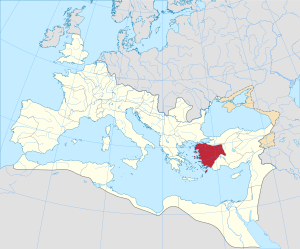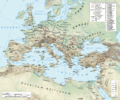Asia (Roman province) facts for kids
Quick facts for kids Provincia Asiaἐπαρχία Ἀσίας |
|||||||||||||||||
|---|---|---|---|---|---|---|---|---|---|---|---|---|---|---|---|---|---|
| Province of the Roman Empire | |||||||||||||||||
| 133 BC–7th century | |||||||||||||||||
 The province of Asia highlighted within the Roman Empire. |
|||||||||||||||||
| Capital | Pergamon (modern Bergama, Turkey), later moved to Ephesus (modern Selçuk, Turkey) |
||||||||||||||||
| Historical era | Classical Antiquity - Late Antiquity | ||||||||||||||||
|
• Conquest of Pergamon
|
133 BC | ||||||||||||||||
|
• Division by Diocletian
|
c. 293 | ||||||||||||||||
|
• Anatolic Theme established
|
7th century | ||||||||||||||||
|
|||||||||||||||||
| Today part of | Turkey Greece |
||||||||||||||||
Asia (Ancient Greek: Ἀσία) was an important Roman province in ancient times. It covered most of western Anatolia, which is now part of Turkey. This province was created in 133 BC when the Roman Republic took over the Attalid Kingdom.
After the Roman Empire was formed by Augustus, Asia became one of the most important provinces. It was managed by a special governor called a proconsul. This system lasted until the province was divided into smaller parts in the 4th century AD.
Asia was one of the richest parts of the Roman Empire. It was mostly peaceful during the time of the emperors. The province had many city-states that mostly governed themselves. These cities often competed with each other for fame and status. They did this by appealing to the Roman authorities and by creating impressive cultural events. These events included festival games, religious ceremonies, and public speaking contests.
Contents
Exploring the Geography of Roman Asia
The province of Asia first included areas like Mysia, the Troad, Aeolis, Lydia, Ionia, Caria, and a path through Pisidia to Pamphylia. Most of the Aegean islands, except for Crete, were also part of this province.
- The western part of Phrygia was added to Asia in 116 BC.
- Lycaonia joined before 100 BC.
- The area around Cibyra was added in 82 BC.
Later, the southeastern part of Asia province was moved to the province of Cilicia. During the Roman Empire, Asia was bordered by Bithynia to the north, Lycia to the south, and Galatia to the east.
A Brief History of Roman Asia
The Name "Asia"
The word "Asia" comes from the Greek word Ἀσία. Originally, this name only referred to the eastern coast of the Aegean Sea. It appears in very old Mycenaean Greek writings as aswia. It probably came from Assuwa, a region's name from the Bronze Age. After the Greco-Persian Wars in the early 5th century BC, Greek writers often used "Asia" to mean the whole continent.
How Rome Gained Control
After Alexander the Great's conquests, different Macedonian kingdoms ruled this land. In 190 BC, the Romans defeated Antiochus III the Great at the battle of Magnesia. In the Treaty of Apamea (188 BC), Antiochus gave up all this territory to the Romans.
The Romans then put most of it under the control of the Attalid dynasty. This kingdom was based in Pergamum. The western part of Phrygia was given to Mithridates V, who was the King of Pontus. Caria and Rhodes received Lycia.
Becoming a Roman Province
King Attalus III of Pergamum was a close friend of Rome. He had no children to inherit his kingdom. So, he decided to leave his kingdom to Rome when he died in 133 BC.
After his death, a person named Eumenes III claimed to be the rightful king and started a rebellion. He even defeated a Roman leader in 131 BC. But the next year, another Roman leader, Marcus Perperna, ended the war. He defeated Eumenes and then surrounded the city where Eumenes had fled. The city had to surrender because of hunger, and Eumenes was captured.
Finally, Manius Aquillius officially made the region into the Roman province of Asia. This gift of the Attalid kingdom to Rome had big effects on nearby lands. During this time, the Kingdom of Pontus grew stronger under its ruler, Mithridates VI. He would become a very tough enemy for Rome in Asia and beyond.
Mithridates and Sulla's Conflict
By 88 BC, Mithridates VI of Pontus had taken over almost all of Asia. He used the local people's dislike of unfair Roman practices to start a huge revolt against Rome. He ordered that all Romans and Italians in the province be killed. Some reports say between 80,000 and 150,000 people died.
Three years later, Lucius Cornelius Sulla defeated Mithridates in the First Mithridatic War. In 85 BC, Sulla reorganized the province. He divided it into eleven court districts. Each district was a main center for several smaller cities. These centers, which later became known as Roman dioceses, included important cities like Ephesus, Pergamum (the old Attalid capital), Smyrna, Adramyttium, Cyzicus, Synnada, Apamea, Miletus, and Halicarnassus.
The first three cities—Ephesus, Pergamum, and Smyrna—were always trying to be the most important city in Asia province. Old rivalries between cities kept them from working together as a whole province.
Augustus's Reforms
When Augustus became emperor, he set up a proconsulship for the province of Asia. This included the regions of Mysia, Lydia, Caria, and Phrygia. To its east, the province of Galatia was created. The proconsul spent most of his year-long term traveling. He would visit each court center to hear legal cases and handle other official duties.
The change from the Roman Republic to the early Empire meant a big shift for the cities. They went from being independent city-states to becoming centers for the Empire's administration.
Augustus's rule also saw new cities grow in Mysia, Lydia, and Phrygia. The province became a complex system of self-governing cities. Each city was in charge of its own money, taxes, and laws in its area. Augustus's reign also marked the start of more cities being built in Asia province. Public building projects became a key feature of a city's importance.
The Province's Decline
The 3rd century AD brought a serious decline to Asia. This was partly due to widespread diseases, like the Antonine plague. It was also caused by local soldiers not following rules and people being less willing to donate to public projects.
The Gothic invasions in the 250s and 260s, which were part of the Crisis of the Third Century, made people feel less safe. Also, as Rome's focus shifted away from Asia, the province lost much of its former importance.
In the 4th century, Emperor Diocletian divided Asia province into seven smaller provinces. During the 5th century and up to the mid-6th century, the cities and provinces of western Anatolia saw their economies grow again. However, after a major plague in 543, many cities further inland declined. By the time of the Persian and Arab invasions in the 7th century, they were hard to tell apart from regular villages.
On the other hand, important cities from the early empire, like Ephesus, Sardis, and Aphrodisias, kept much of their greatness. They became the new provincial capitals. Asia remained a center of the main Hellenistic (Greek-influenced) culture in the east for hundreds of years. The territory stayed part of the (Eastern) Roman Empire until the end of the 14th century. Then, it was conquered by the Ottoman Empire.
How Roman Asia Was Governed
Taxes in Asia Province
Rome was usually careful about getting involved in eastern affairs. It often relied on allies to help solve conflicts. Rome rarely sent officials to the east, and it usually didn't have a strong government presence there. This lack of interest didn't change much even after Attalus gave his kingdom to Rome in 133 BC. In fact, some parts of the Pergamene kingdom were even given away to other nations. For example, Great Phrygia was given to Mithridates V of Pontus.
While the Roman Senate was slow to get involved in Asian matters, others were not. A law passed by Gaius Gracchus in 123 BC gave the right to collect taxes in Asia to members of the equestrian order. These individuals from the Roman Republic almost certainly took advantage of this privilege to make money.
If a community couldn't pay its taxes, they would borrow money from Roman lenders. But these loans came with very high interest rates. This often led to communities not being able to pay back their loans. As a result, Roman lenders would take the borrower's land, which was their last valuable possession. This is one way, along with direct purchases, that Romans spread out across the province of Asia.
Roman Soldiers in Asia
Except for putting down occasional revolts, there were very few Roman soldiers in Asia province. This changed when forces led by Sulla began their campaign against Mithridates VI. In fact, Asia province was special because it was one of the few provinces in the empire that didn't have a permanent army base.
While no full legions were ever stationed inside the province, there were still some soldiers. Small groups of legionary soldiers were present in the Phrygian cities of Apamea and Amorium. Auxiliary cohorts (smaller military units) were stationed in Phrygian Eumeneia. Also, smaller groups of soldiers regularly patrolled the mountainous areas. A large military presence in rural areas around the 3rd century AD caused a lot of unrest among the people in the province.
The Imperial Cult
The Imperial cult was very common in Roman provinces. This was a religious practice where emperors were honored, sometimes even like gods. Soon after Augustus became emperor, temples built in his honor appeared all over Asia province.
The creation of provincial centers for the imperial cult also led to local cults. These places served as examples for other provinces throughout the empire.
The imperial cult helped people in Asia province accept Roman rule within their own communities. Religious practices were very public. They involved citizens in all parts, including prayer, sacrifice, and parades. Rituals held to honor a specific emperor often happened more often than those for other gods. No other religious practice was as widespread or common as the imperial cult.
See also
- List of Roman governors of Asia
- Early centers of Christianity#Anatolia
- Asiarch
Images for kids



